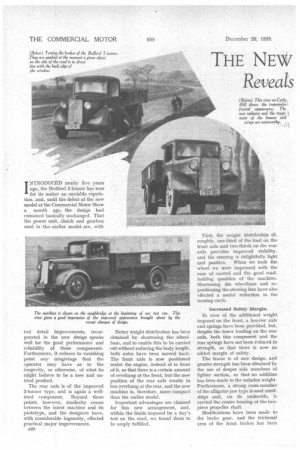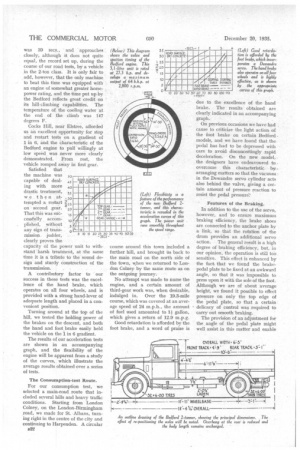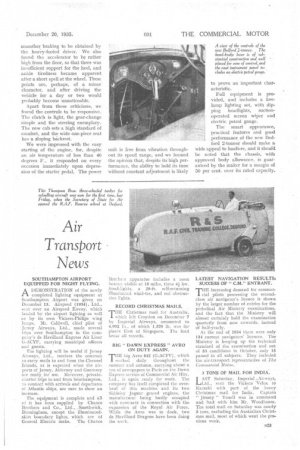THE NEW BEDFORD 2-TONNER Revectis Sterling Qualities
Page 30

Page 31

Page 32

Page 33

If you've noticed an error in this article please click here to report it so we can fix it.
INTRODUCED nearly five years ago, the Bedford 2-tonner has won for its maker an enviable reputation, and, until the debut of the new model at the Commercial Motor Show a month ago, the design had remained basically unchanged. That the power unit, clutch and gearbox used in' the. earlier model. are, , with
but detail improvements, incorporated in the new design speaks well for the good performance and reliability of these components. Furthermore, it reduces to vanishing point any misgivings that the operator may have as to the longevity, or otherwise, of what he might believe to be a new and untried product.
The rear axle is of the improved 3-tonner type, and is again a welltried component. Beyond these points, however, similarity ceases between the latest machine and its prototype, and the designers have, with considerable ingenuity, effected practical major improvements.
B20 Better weight distribution has been obtained by shortening the wheelbase, and to enable this to be carried out without reducing the body length, both axles have been moved back. The front axle is now positioned under the engine, instead of in front of it, so that there is a certain amount of overhang at the front, but the new position of the rear axle results in less overhang at the rear, and the new machine is, therefore, more compact than the earlier Model.
important advantages are claimed for this new arrangement, and, within the limits imposed by a day's test on the road, we found them to be amply fulfilled. First, the weight distribution of, roughly, one-third of the load on the front axle and two-thirds on the rear axle provides improved stability. and the steering is delightfully light and positive. When we took the wheel we were impressed with the ease of control and the good roadholding qualities of the machine. Shortening the wheelbase and repositioning the .steering box have also effected a useful reduction in the turning circle.
Increased Safety Margin.
In view of the additional weight imposed on the front, a heavier axle and springs have been provided, but, despite the lower loading on the rear axle, both this component and the rear springs have not been reduced in strength, so that there is now an added margin of safety.
The frame is of new design, and greater strength has been obtained by the use of deeper side members of lighter section, so that no addition has been made to the unladen weight. Furthermore, a strong cross-member of the alligator-jaw type is used amidships and, on its underside, is carried the centre bearing of the twopiece propeller shaft.
Modifications have been made to the brake gear, and the frictional area of the front brakes has been increased. Finally, the appearance of the vehicle has been greatly improved by the provision of a new radiator of attractive design, a new cab and the successful redesigning of the front end.
These remarks give a broad outline of the important changes which have been made in the new model, but for the many detail improvements that have been incorporated we would refer the reader to the full description of the new 2-tonners which appeared in our issue dated November 1 last. Proceeding, then, to our impressions on the road and the results of our tests; we took over the vehicle, which carried a pay-load of two tons, at the maker's Hendon service depot, and, after running to the weighbridge, we made for Brockley Hill to enable us to gauge its hillch mbmg capabilities.
• A Good Climb.
It is our custom to time vehicles submitted to us for road test over the steepest portion of this climb, which
includes a section of 1 in and is
approximately. 4.-mile in length. Changing down to third gear, before the beginning of the timed section, we passed the milestone at 28 m.p.h., continuing in this ratio until the speed had dropped to 18 m.p.h., when a change to "second " was made. The climb was completed in this gear, -the minimum speed on the steepest part of the hill being 15 m.p.h., whilst the speed at the water trough, which marks the completion of the climb, had risen to 21 m.p.h.
The time taken over tne section was 39 secs., and approaches closely, although it does not quite equal, the record set up, during the course of our road tests, by a vehicle in the 2-ton class. It is only fair to add, however, that the only machine to beat this time was equipped with an engine of somewhat greater horsepower rating, and the time put up by the Bedford reflects great credit on its hill-climbing capabilities. The temperature of the cooling water at the end of the climb was 147 degrees F.
Cocks Hill, near Elstree, afforded us an excellent opportunity for stop and restart tests on a gradient of 1 in 6, and the characteristic of the Bedford engine to pull willingly at low speed was never more clearly demonstrated. From rest, the vehicle romped away in first gear.
Satisfied that the machine was capable of dealing with more drastic treatment, we then attempted a restart on second gear. That this was successfully accom lighed without any sign of transmission judder, clearly proves the capacity of the power unit to withstand harsh treatment, at the same time it is a tribute to the sound design and sturdy construction of the transmission.
ROAD SURFACt, DRY CONCRETE.
•
* LirArd
••
11111•1111
0
r2 9:
MEM ran
50 A 5 40 3,5 30
20 15 10
5 0
A contributory factor to our success in these tests was the excellence of the hand brake, which operates on all four wheels, and is provided with a strong hand-lever of adequate length and placed in a convenient position.
Turning around at the top of the hill, we tested the holding power of the brakes on the descent, and both the hand and foot brake easily held the vehicle on the i in 6 gradient.
The results of our acceleration tests are shown in an accompanying graph, and the flexibility of the engine will be apparent from a study of the curves, which illustrate the average results obtained over a series of tests.
The Consumption-test Route.
For our consumption test, we selected a main-road route that included several hills and heavy traffic conditions. Starting from London Colney, on the London-Birmingham road, we made for St. Albans, turning right in the centre of the city and continuing to Harpenden. A circular 522 course around this town included a further hill, and brought Us back to the main road on the north side of the town, when we returned to London Colney by the same route as on the outgoing journey.
No attempt was made to nurse the engine, and a certain amount of third-gear work was, when desirable, indulged in. Over the 19.3-mile course, which was covered at an average speed of 24 m.p.h., the amount of fuel used amounted to 1 gallon, which gives a return of 12.9 m.p.g.
Good retardation is afforded by the foot brake, and a word of praise is due to the excellence of the hand brake. The results obtained are clearly indicated in an accompanying graph.
On previous occasions we have had cause to criticize the light action of the foot brake on certain Bedford models, and we have found that the pedal has had to be depressed with care to avoid disconcertingly rapid deceleration. On the new model, the designers have endeavoured to overcome this characteristic by. arranging matters so that the vacuum in the Dewandre servo cylinder acts also behind the valve, giving a certain amount of pressure reaction to resist the pedal pressure':
• Features of the Braking.
In addition to the use of the servo, however, and to ensure maximum braking efficiency, the brake shoes are connected to the anchor plate by a link, so that the rotation of the drum provides an additional servo action. The general result is a high degree of braking efficiency, but, in our opinion, the operation is still too sensitive. This effect is enhanced by the fact. that we found the brakepedal plate to be fixed at an awkward angle, so that it was impossible to press upon it with the sole of the foot. Although we are of about average height, we found it possible to effect pressure on only the top edge of the pedal plate, so that a certain' delicacy of control was required to carry out smooth braking.
The provision of an adjustment for the angle of the pedal plate might well assist in this matter and enable smoother braking to be obtained by the heavy-footed driver. We also found the accelerator to be rather high from the floor, so that there was insufficient support for the heel, and ankle tiredness became apparent after a short spell at the wheel. These points are, perhaps, of a minor character, and after driving the vehicle for a day or two would probably become unnoticeable.
Apart from these criticisms, we found the controls to be responsive. The clutch is light, the gear-change simple and the steering exemplary. The new cab sets a high standard of comfort, and the wide one-piece seat has a sloping backrest.
We were impressed with the easy starting of the engine, for, despite an air temperature of less than 40 degrees F., it responded on every occasion immediately upon depression of the starter pedal. The power unit is free from vibration throughout its speed range, rand We formed the opinion that, despite its' high performance, the ability to hold its tune without constant adjustment is likely to prove an important characteristic.
Full equipment is provided, and includes a fivelamp lighting set, with dipping headlights, suctionoperated screen wiper and electric petrol gauge.
The smart appearance, practical features and good performance of the new Bedford 2-tonner should make a wide appeal to hauliers, and it shoulki be noted that the chassis, with approved body allowance, is guaranteed by the maker for a margin of 50 per cent. over its rated capacity.




















































































